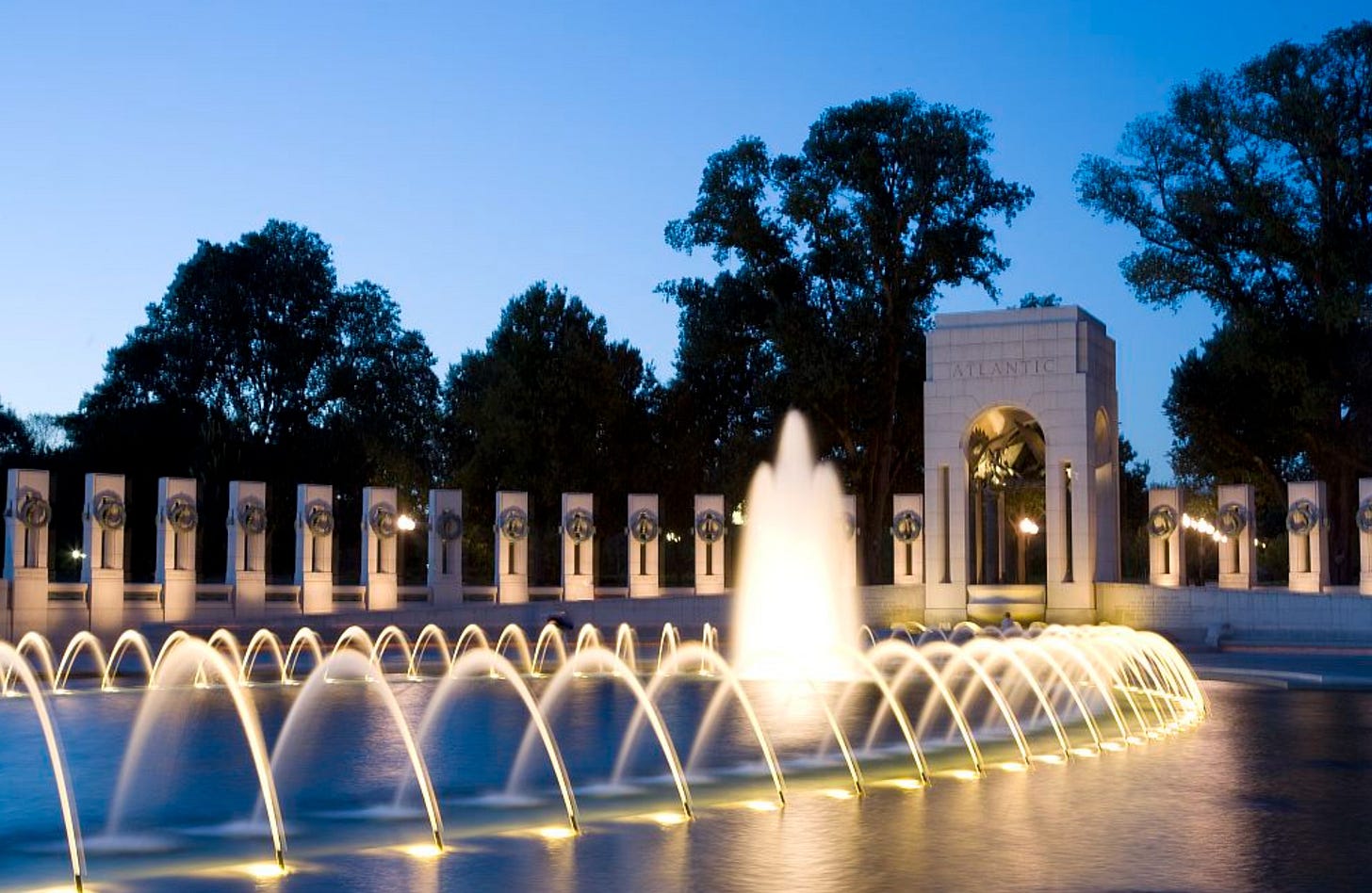TDIH: World War II Memorial
A memorial might not have happened but for Roger Durbin. He was a mail carrier and an Army veteran who’d fought at the Battle of the Bulge.
On this weekend in 2004, our country begins a four-day celebration that would culminate in the dedication of the World War II Memorial. It had been nearly 60 years since that war ended.
Why did it take so long to honor the Greatest Generation? The question is often asked.
“[B]y being built after the Vietnam Veterans Memorial and Korean War Veterans Memorial, the National World War II Memorial came to life out of sequence,” historian Nicolaus Mills concludes.
But a memorial simply hadn’t been a priority in the years after World War II. Many veterans were individually honored when they came home, but most simply wanted to get back to their real lives. A memorial become a priority only when the last of that generation started passing away.
Even then, a memorial might not have happened but for Roger Durbin. He was a mail carrier and an Army veteran who’d fought at the Battle of the Bulge. He’d once visited Washington, D.C. and wondered where the tribute to World War II veterans was. It must have been rankling at the back of his mind? Many years later, he had the opportunity to ask his Congresswoman about it. They were both attending the town’s annual fish fry.
“I turned and faced a solidly built graying gentleman with a square jaw, twinkling eyes, and a churlish grin,” Rep. Marcy Kaptur later remembered. She reassured Durbin that there was a WWII memorial: The statute of Marines raising a flag on Iwo Jima.
But Durbin emphatically disagreed. That memorial is for just one branch of the service, he told Kaptur. “His feet were firmly planted, his jaw squared,” recalled Rep. Kaptur. “He was trying to make a spectacle and put me on the spot, and he was having a royal time doing it.”
Either way, he’d caught her attention, and that conversation proved to be the first step in the long road to a memorial. Kaptur first introduced legislation proposing a memorial in 1987; the idea was finally approved in 1993.
Unfortunately, disagreements and controversy over the Memorial were just beginning. Conflict followed on virtually everything: Where to put the Memorial, how to finance it, and what sort of design might be appropriate. Throughout it all, Durbin was intimately involved, writing letters, making phone calls—doing anything to move the project forward. His son Peter later said that the Memorial was “the driving force” of his father’s life.
The Memorial’s groundbreaking finally occurred in late 2000. Sadly, Durbin wasn’t there to see it. He’d passed away of pancreatic cancer mere months before.
“In a sense, when we lost him, it kind of encapsulated what we had been saying for so long about the urgency of completing this tribute, of how rapidly we were losing that special generation,” the associate executive director of the Memorial concluded.
Today, the World War II Memorial stands on the National Mall between the Lincoln Memorial and the Washington Monument. Fifty-six granite pillars stand in a semicircle: one for each state and American territory. A pool stands between two arches, which read “Atlantic” and “Pacific” for the two theaters of war. A Freedom Wall hosts gold stars representing Americans who were killed during the war.
Nearly 5 million people visited the Memorial, just last year. And, to think, it all started because one man was determined to do something. He wanted future Americans to remember the sacrifices of the Greatest Generation.
“It’s almost unbelievable,” Durbin’s son Peter concluded. “We didn’t have a clue that it would go this far or that he would be in the center of this. He was so persistent.”
Have a blessed Memorial Day weekend.
Sources can always be found on my website, here.





The WWII is truly a Great Memorial to be seen honoring the Greatest Generation. That Memorial in my opinion in my opinion not only represents the Veterans of that war, our entire nation pitched in to fight that war. It wasn’t just the military, it was the Rosie Rivetors, the; paper, tire, aluminum, tin, etc. captains who led those drives. People did what ever they could to win the War to end all wars. It is so sad that it didn’t end all wars, but at least the people all pulled together to do what they could to support our country.
❤️🇺🇸🇺🇸🇺🇸
Finally, Roger Durbin got the job done!
A Memorial is built to those who fought gallantly for their nation, their families and future generations of Americans!
It took a Greatest Generation Veteran to get the job done for all who served during WWII!
Thank you, Tara, for this fine story!